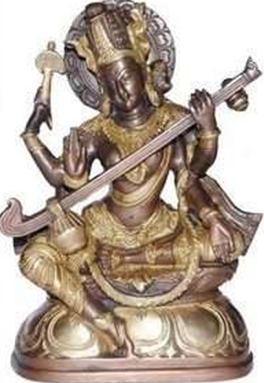Talk:Saguṇa Brahmaṇ As Mūrti:Two Viewpoints about worshipping Mūrtis
By Sri Vishal Agarwal
There are two ways in which peoples interpret the use and nature of Mūrtis – as an abode of Brahman, or as a symbol of Brahman. Lay peoples do not necessarily view these two interpretations as necessarily exclusive (‘either this or that’) to each other, or they may accord primacy to one of the two due to their own personal preferences or due to their self-association with a particular tradition of peoples. Whatever be the interpretation, both of them have the same purpose – of making Brahman more accessible to the lay worshipper.
1. The Mūrti as a Symbol of Saguṇa Brahman: Once Svāmī Vivekānanda during his itinerary arrived at Alwar. The Dewān (Prime Minister) of the state kept him in his house as a guest, being impressed by the Svāmī’s personality, learning and spirituality. He once invited the Mahārāja to listen to the discourses of the Svāmī and benefit from his wisdom.
The Mahārāja said to the Svāmī, “My forefathers had consecrated an image of Śrī Kṛṣṇa inside the palace. But I do not worship it because I do not have faith in idol worship. Don’t you think that idol worship is harmful?”
Svāmījī thought for a while and then asked some persons to get a picture of the Mahārāja to the gathering. Then, he asked people to spit on it. Everyone was aghast. They said to Svāmījī, “How can you ask us to spit on this picture? It is of the Mahārāja whom we all revere and respect.”
Svāmījī smiled and said to the Mahārāja, “Did you see how no one wants to spit on this picture? The picture is not the same as you. It is merely a painting of you on a piece of paper. Yet, it symbolizes you and represents you which is why no one wants to spit on it. These same people who have refused to spit on this picture have no problems spitting into the expensive silver and gold spittoons kept in the Dewān’s house. Similarly, the image of Śrī Kṛṣṇa reminds the worshipper of the Bhagavān whom it represents. The worshipper knows that the image is not the same as the Bhagavān, but this image reminds him of the Bhagavān whom he worships in his heart. And when he offers worship to this image, he is offering worship to Śrī Kṛṣṇa that the image represents.”
The Mahārāja learned his lesson about the rationale behind idol worship and promised to Svāmījī that he will not henceforth look down upon ‘mūrti pūjā’.[1]
To conclude again, in the words of T. M. P. Mahādevan (1956: 47–48):
"The function of the idol is symbolic. No Hindu, however unlettered he may be, regards the idol as exhausting the being of Bhagavān. To see Bhagavān everywhere and to practice the presence of Bhagavān always is impossible for the ordinary individual. And so he is asked to behold the manifestation of Bhagavān, wherever there is splendor, beauty and love. “Whatever being there is, endowed with grandeur, beauty or strength,” says Śrī Kṛṣṇa, “know that it has sprung only from a spark of my splendor (Gītā 10.41).” Temples are built on beautiful spots in order that man may be reminded of Bhagavān, the master artist, and get into communion with Him.” (pp. 47–48)
2. The Mūrti as an Abode of Brahman: For many peoples however, the mūrti is not just a symbol of the Divine. It is rather the body of Bhagavān, and divine as such. However, this does not mean that peoples practice idolatry, which would mean reducing Brahman to the idol. Rather, peoples believe that Brahman is graciously present in the mūrti, but it is wrong to think that Brahman is present in the mūrti alone. [2]
This distinction is explained by Rambachan: [3]
"The Hindu acceptance of the arcāvatāra concept has to be understood in the context of its prevalent views about the nature of Bhagavān and His relationship to the world. According to Rāmānuja, Bhagavān is the only reality. There is no existence outside or independent of Bhagavān. Bhagavān, however, contains within Himself the world of individual souls and material objects.
Within the all-inclusive Bhagavān exist unconscious matter and finite spirits. Rāmānuja uses the analogy of the body and soul for clarifying the relationship between the Bhagavān and the universe. Matter and souls are conceived of as constituting the body of Bhagavān. Bhagavān, as the soul of the entire universe, pervades, controls, guides and uses it as an instrument.
For the Advaita philosopher Śaṅkara, the entire universe is an inexplicable appearance of Bhagavān who is both its intelligent and material cause. In either view, the universe as a whole and all its particular forms are pervaded by Bhagavān. All forms belong to Bhagavān and each can serve as a medium for appreciating and worshipping Him. The fact that the axis of the universe literally runs through everything, grants to all objects the potential for revealing Bhagavān.
The persistent equation of the arcāvatāra concept with idolatry ought also to be examined in the light of the clear and strong affirmation of divine transcendence in Hindu Dharm… in Vaiṣṇava theology, the arcā form is only one of the five ways in which the Bhagavān is understood to manifest Himself. The Hindu concept of Bhagavān as both immanent in the world and transcendent over it is expressed figuratively in the Vedas in the view that Bhagavān pervades the world by a fourth of his being, while three-fourths of him remain beyond it. The Bhagavadgītā similarly affirms that while the entire universe owes its being to Bhagavān, the forms of the universe do not contain or express him fully (9.4–5). It is clearly recognized that no finite process or form can ever finally express the absolute. Ultimately, however, we appreciate the limitations of all our concepts and forms of worship…"


